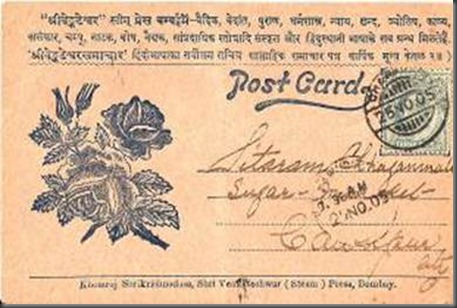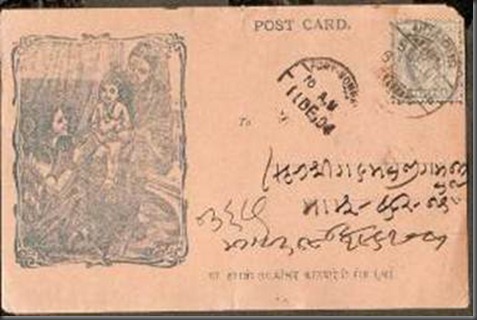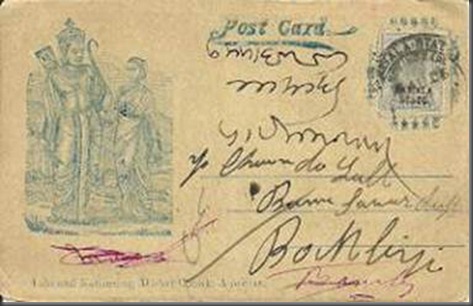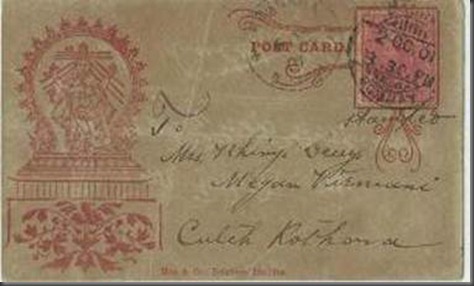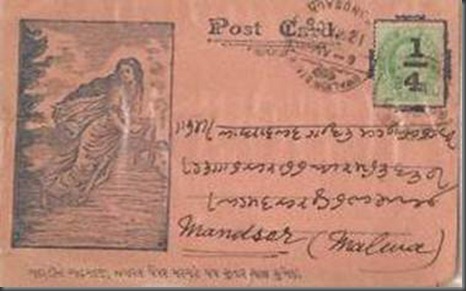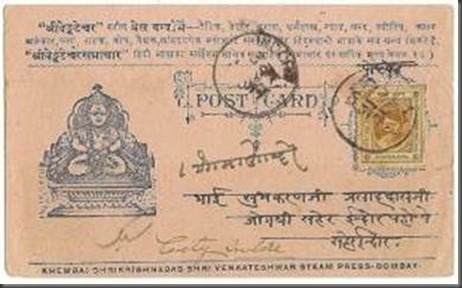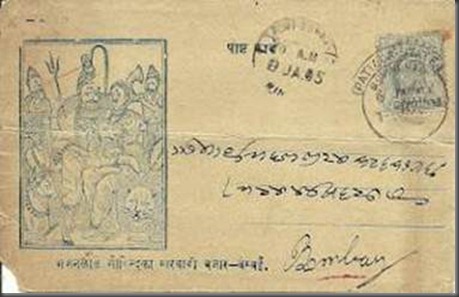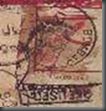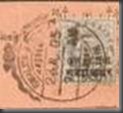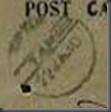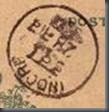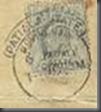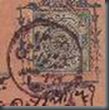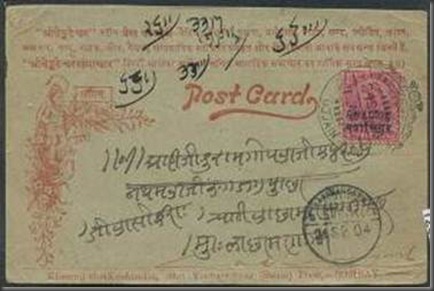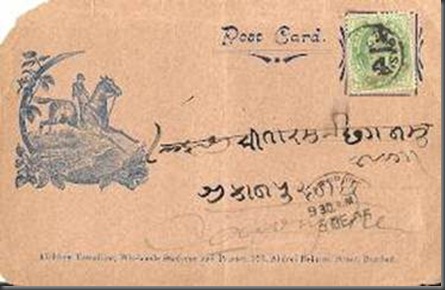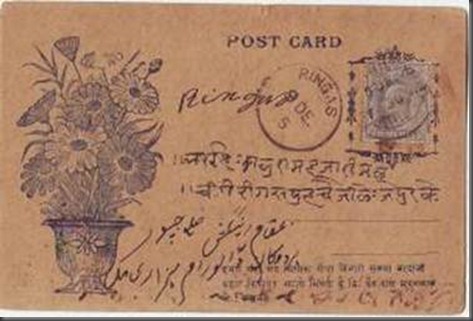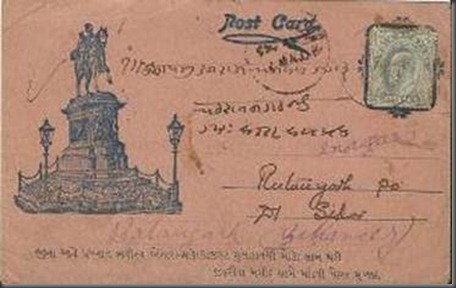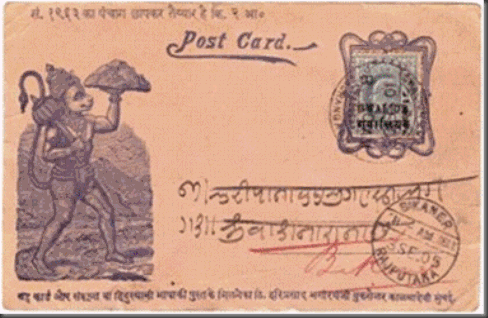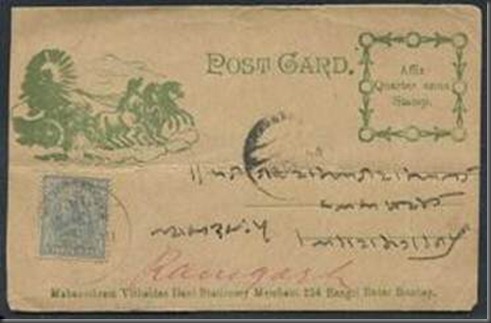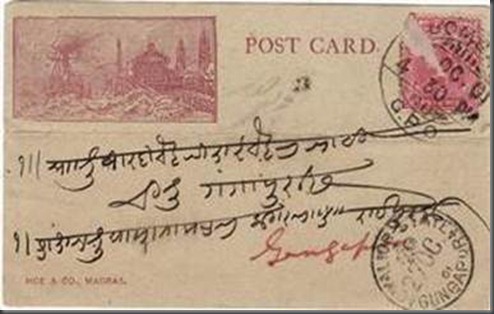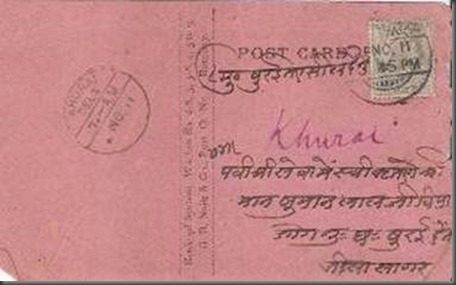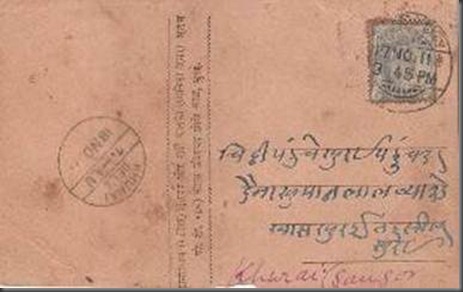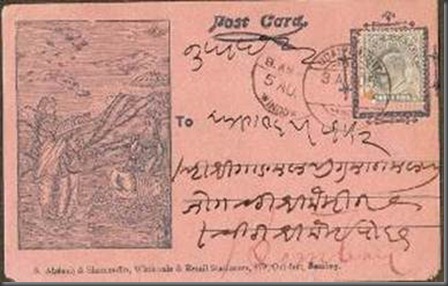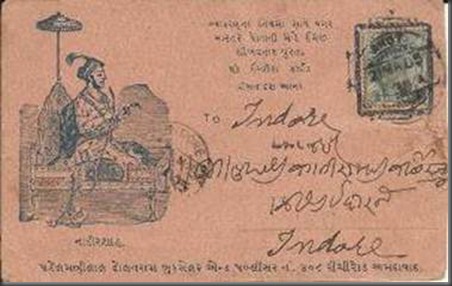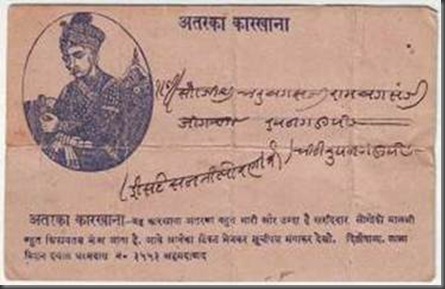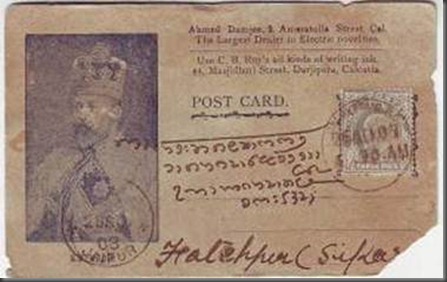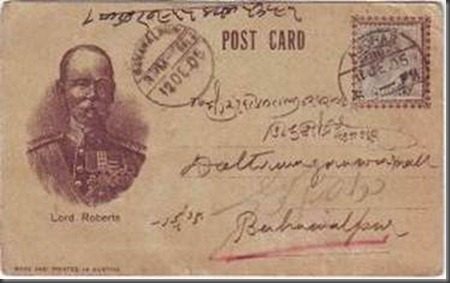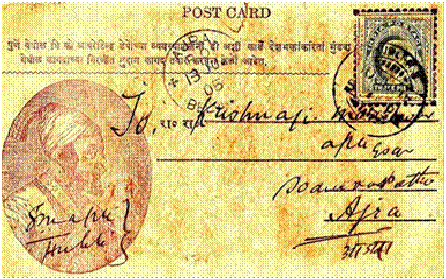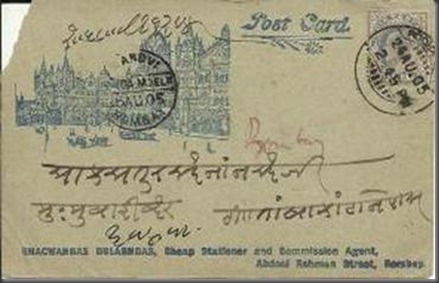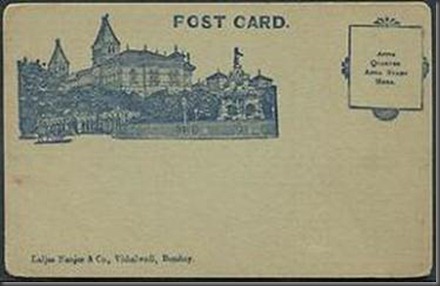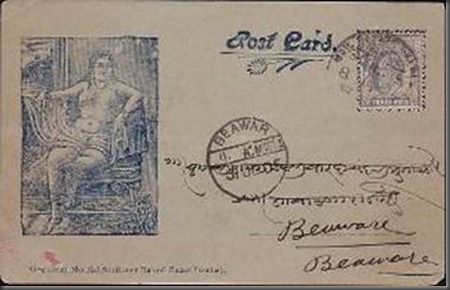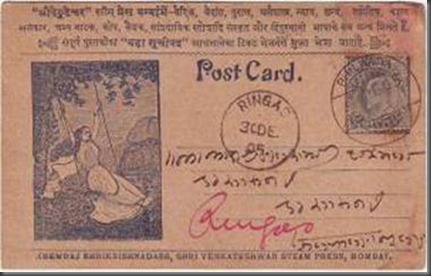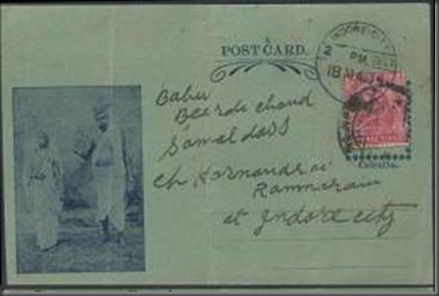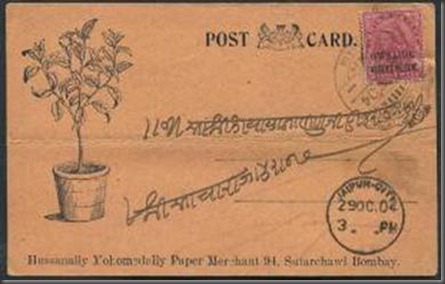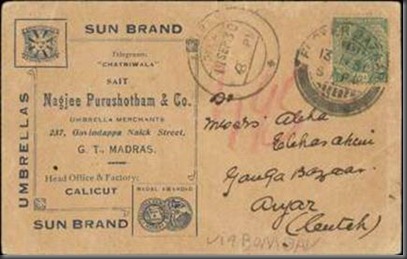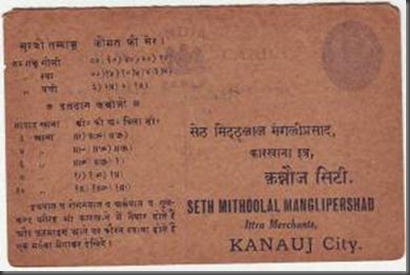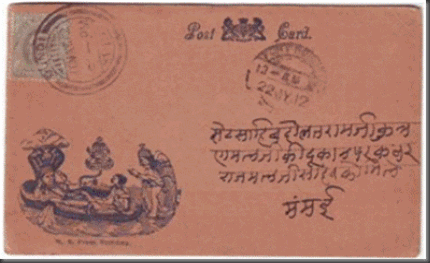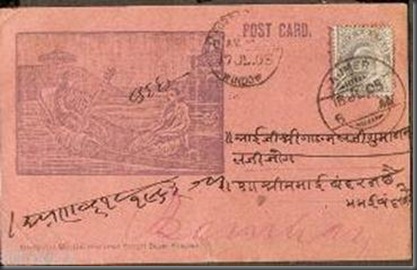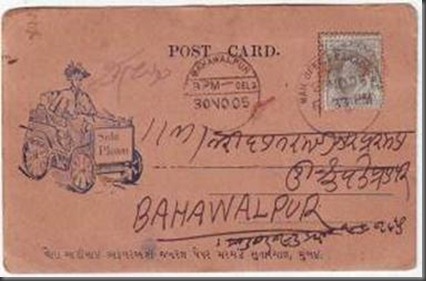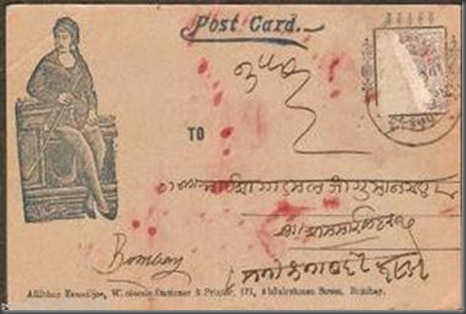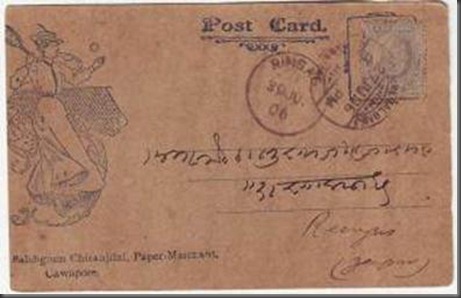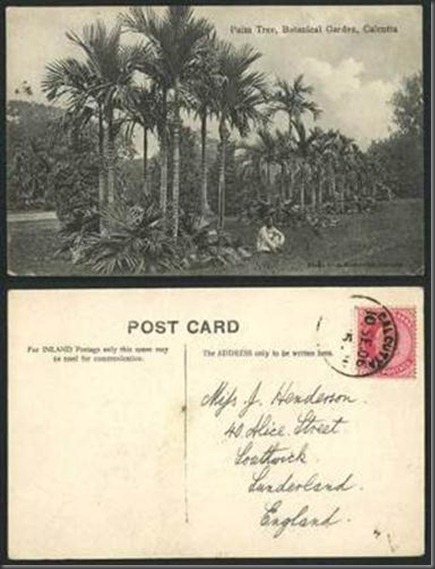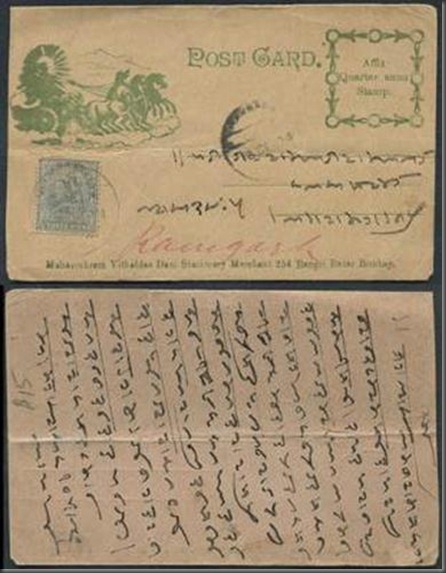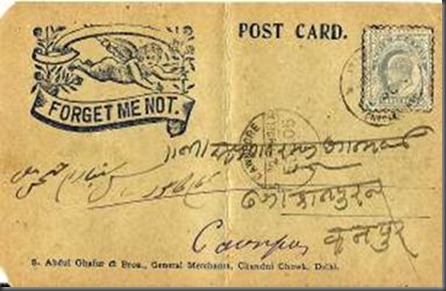BRITISH INDIA BAZAAR CARDS
( A PERIODIC PHILATELIC REVOLUTION AND MIRROR OF SOCIAL HISTORY )
- Naresh Agarwal
Stamps
are considered as mirror of art, culture, history, religion, mythology
and other aspects of any country or society but it is not only stamps
but other postal material and stationery also share their part for the
same purpose. Various philatelic materials depict and project various
such aspects through the quotes, slogan, text or pictorial
advertisements, vignettes printed on them and also through
cancellations, postmarks, labels and private text and sketches drawn /
written on them.
Postcards
are popular because of the wide range of subjects, with just about
every subject imaginable being at some time has been portrayed on a
postcard. History itself can be tracked on postcards, be it historical
buildings, famous people, art, culture, streets, bazaars, economical
development, social atmosphere etc.
POST CARDS AND POSTAL CARDS :
Normally,
the term “Postal Card” referred to cards that were printed and sold by a
governmental body with postage paid indicia preprinted on them. The
term “Postcard” referred to cards which were privately produced with
postage prepaid and were not sold by govt. body. However, today the
cards issued by govt. bodies are also called Post Cards.
BRITISH INDIA KGVII 3P IILLUSTRATED 1903 BRITISH INDIA ILLUSTRAED POSTAL CARD WITH
BAZAAR POST CARD 1905 PREPRINTED POSTAGE PREPAID INDICIA
The
practice of having picture on either side of the post card was first
started in London in 1840 when the maker of card wrote the postcard to
himself only followed by first regularly produced, privately made
/non-postal postcard, where postage had to be affixed was introduced in
Austria in 1869.However, in U.S., the private card known as Lipman card
adorned with a small border and labeled "Lipman's Postal Card was first
produced in the Philadelphia in 1861 which was in market until 1873 when
the first U.S. Government Postcards appeared.
HISTORY OF INDIAN POSTAL CARD IN BRITISH INDIA :
In July 1879, the Post Office of India introduced a 1/4 Aana postcard that provided postage from one place to another within British India. This was the cheapest form of post provided to the Indian people to date and proved a huge success.
1894 : EAST INDIA POSTAL CARD 1905 : INDIA POSTAL CARD
The
establishment of a large postal system spanning India resulted in
unprecedented postal access where a message on a postcard could be sent
from one part of the country to another part (often to a physical
address without a nearby post office) without additional postage
affixed. This was followed in April 1880 by postcards meant specifically
for government use and by reply post cards in 1890.The postcard
facility still continues to this date in Independent India.
The
British occupation of India lasted just under two hundred years, and by
the beginning of the last century, life there was being recorded on
postcards (known as picture postcards) to be sent by the thousand back
home to England. Families stationed in the subcontinent sent home
amazing images of India showing its art, culture, architect, defense,
social and economic conditions or of cities such as Calcutta or Delhi or
Madras or Mumbai imaging the ‘daily life’ of ethnic Indians along with
pictures of famous landmarks, scenic views, photographs or drawings of
celebrities and so on. These cards had mainly one full side with image (
photographic or painted or sketched ) printed in multi color or light
printing with single color.
BRITISH INDIA BAZAAR POSTCARDS :.
British India period around the start of 20th centaury spanning mainly from the year 1900 to 1930, saw a great revolution in changing trends of postal cards which were in immense use during that period. When
there was great impact of British rule and culture and on the other
hand it was India and Indian culture which was struggling to survive.
Such post cards gave new direction to postal culture and gave new
dimensions to the utility of this mode of postal communication. Apart
from those which had pre paid printed stamps issued by postal
administration, that period saw a new culture of substantial use of
private printed pictorial postal cards. Such post cards were developed
mainly by the merchants, businessman and traders of major cities of all
over India who advertised their products or business through text or
pictorial matters printed on the either side of the post cards or postal
covers which used adhesive postal stamps ( 3Pies/4pies Edward VII and
George V period ) affixed on them for payment of postage. This period is
also known as classis post card because of the image printed on it.
1904 & 1905 : BRITISH INDIA BAZAAR CARDS
1905 & 1906 : BRITISH BAZAAR CARD
Such
post cards and covers of this era were in fact illustrated advertising
postcards and envelopes from various merchants in larger cities (Bombay,
Delhi, Madras, Poona City etc.) promoting their products. These private
printed post cards mainly showed printing of various pictures/ glimpse
of various products being introduced in the market and glimpse of
various fascinating selection of patriotic, religious and socially
relevant themes showing places, women in different postures and moods,
various phases of human life, mythology based pictures of various
religions, patriots, celebrities, rulers and warriors, and many other
which were either printed by individual merchants / traders giving
specific quotes and pictures or were also available in market with some
standard pictorial printing done on either side of the cards. Such
private printed post cards which were also on common sale in the market
for usage even by non- merchants. Because those cards were mainly used
by the merchants of bazaars of India for their business transactions and
communication; for promotion of their goods and products to customers
and suppliers; the cards were known as Bazaar Cards.
NOMENCLATURE :
The
Bazaar cards as nothing but private pictorial printed post cards
printed by individual concerns with their product advertisement in text
or picture or were available in open market on public sale. In practice
,these cards were mainly used by merchants, traders and businessmen
usually for their business and trade purposes such a daily prices
exchange and other information sharing; these were initially termed as
Bazaar Bhaw cards, Advertising Cards, Merchant cards and Business Cards.
At some places at some times these were also called Aditya Cards,
Swadeshi Cards, Printer’s Cards, Message Cards, Regular Cards, Market
Cards Bazaar Propaganda post Card etc. etc.. But later only in 1987/88
the terms Bazaar Card was coined by one philatelist Mr. Dipesh SEN of
Deccan Philatelic Club, Pune which was widely accepted by philatelists
and collectors. Hence, the name Bazaar Cards came in to practice.
A PHILATEIC STUDY :
POSTAGE /POSTAL CHARGES :
As
these were private printed post cards, the postage had to be paid as
per then prevailing postal rates by way of affixing postal stamps.
During the period when these cards were in maximum usage that is 1900 to
1930, the postal rates were same as that for postal cards i.e. ¼ anna
or 3Pies or 4 pies. One can find stamps of . Edward VII and George V and
also Queen Victoria. There was no extra charge for such private printed
post cards. Such postal charges prevailed all over India as these cards
were used all around in India.
1906 : Postage Stamp Overprinted ¼ anna 1907: Indore state ¼ anna postage stamp
1904 AND 1906 BAZAAR CARDS SHOWS POSTSAGE AS 3 PIES
CANCELLATIONS AND POST MARKS :
Though
postal cancellations were being put as usual as on other mails mainly
Cds but in some states, as they used their own stamps they had their own
cancellations too like Gwalior sate had Cobra snake typical
cancellation. Various different postmarks were also used during that
period.
CDS,SQUARE (DLO) & RECTENGULAR (REFUSED). 1905 : TWIN COBRA- SNAKE CANCELLATION
CANCELLATIONS / POST MARLKS OF 1905 GWALIOR OVERPRINT
1906 : FRANKED WITH STATE POSTAGE STAMPS 1905 : CROWNED CDS CANCELLATION
DIFFERENT CANCELLATIONS AND POSTMARKS SHOWN BY THE ABOVE BAZAAR CARDS
Stamps :
Some
states used their own postage stamps like Indore state, Hydrabad and
many other during the transitional period. Bot mainly King Edward VII 3
pies stamps were used. However, Queen Victoria 3 pies stamps were also
in use.
3Pies KEVII STAMP AFFIXED ON 1905 3Pies KEVII STAMP AFFIXED ON 1904
BAZAAR OVERPRINTED GWALIOR. BAZAAR OVERPRINTED ¼ ANNA
1905 : BRITISH INDIA BAZAAR CARDS SHOWS KING GEORGE VII 3 PIES STAMPS USED AS POSTAGE
TECHNICAL ASPECTS :
PAPER :
These Bazaar cards were printed on paper card sheet (thin card board)
of 0.5 mm to 0.6 mm thick. The card has rough surface and were not
uniform in GSM.
SIZE AND DIMENSIONS :
The
Bazaar cards were cut in to rectangular shape almost in similar size
all over with slight variations at times. The common dimensions used to
be 139 x 89mm (14 x 9 cm) with seldom some variation up to 14.5 x 9.1
cm.
COLOR :
The cards were normally printed on white card sheet but one could find
some other colors too such as light yellow, reddish brown, pink, light
brown and many more. The printing too has been found done by different
printers in different colors.
Bazaar Cards could be found on papers sheets with different colors but printing normally found done with one color
DESIGN FEATURES :
The
bazaar cards had specific design of pictorial images mainly on the one
half portion of address side. Though some cards with images on other
side could be found. The images covered wide range of designs printed
mainly with one color ink with some exceptions too.
ORNAMENTAL BORDER FOR SPACE FOR AFFIXING STAMPS
The
design normally showed space for affixing stamps for postage payment
with artistic designs and ornamental border and nicely collared..
1928 BAZAAR CARD : DARK COLOR IMAGES TOO 1901 : USING CORNER FOR PICTORIAL IMAGES
The pictorial images were normally printed on the undivided (some times divided) back with
address on one half and the image on the other. However, some cards with
corner printing or almost 1/4 part printed were also available.
Some
cards with no picture but advertisement of the product given in the two
line dividing strip of the back side were also available. That gave
more space to the writer.
PRINTERS AND PUBLISHERS :
The early Indian postcards were generally printed in Germany, France, Britain and Austria.
“Raphael Tuck's” in London, “Plate’ in Colombo and “D.A. Ahuja” in Rangoon and “
were among the leading all-India publishers of color postcards and
were the source of many other images. There were some smaller print runs
by painters like Joseph Hoffman of Australia and the British Mortimer Menpes, or an anonymous amateur too who published a series of his own paintings till 1910.
But after 1900, Bombay became the printing and publishing hub of such post cards. M/S Ravi Varma
was one of the exceptions, with his famous press outside Bombay also
printing postcards before 1900. To name a few Bombay based printers are Khemraj
Srikrishnadas, Sri Venkateshwar (Steam) Press, The Parole Maxim Co.,
Hariprasad Bhograthji Bookseller, Pandit Shridhar Shivlalji ‘Gyansagar’
Chhapakhana, etc.
Normally the cards had the name and detailed address of printer or sales agent
printed on it to inform its availability
The
Bazaar cards were mainly printed initially in Bombay only and later in
different cities of India by local printers such as M/S Moorli Dhur & Sons in Amballa and M/S H.A. Mirza & Sons
in Delhi were two other prominent postcard publishers which used to get
their printing done from Germany and other countries too. Their work
covered literally hundreds of locations from the largest cities to the
smallest cantonments. Small publishers also emerged in other cities too
like Kanpur, Agra, Hathras, Lahore, Amritsar, Indore, Jaipur etc. Some
other small publishers also emerged in South and East too to cater local
requirements. Post card traders, agents and merchants also came in to
scene all over.
CIRCULATING AREA :
Though
these cards were mainly used by merchants and traders but as the
business activities were not confined to particular area, these cards
traveled long distances too. Though their main transit remained in
particular state but as these cards were used all over India at that
time, these registered their existence all over from North to West and
East to South. Hence. these created a big scope. One can find these
cards in Delhi Agra Jaipur to Kolkatta and Bombay Nasik to Trichunapalli
Bazaar Card to Hyderabad : Postage 4pies 1906 Letter to Bundi(Rajasthan) : postage 3pies
SALES :
Bazaar
post cards were on sales in the general market at stationery shops to
at that times. As these were in massive use by traders and merchants,
these were available in whole sale. Even advertisements were done on
these cards mentioning availability and sales of these cards. The price
was quite low. Such as Rs.1-8 for 1000 pcs.
1906 BAZAAR POST CRAD ADERTISE AVAILABILITY AND SALES OF BAZAAR CARDS
These cards are available at Rs. 1-8 per 1000 from Hukamchand Ishwardass & Co.,
General Suppliers & Commission Agents, Marwari Bazar, Bombay
HERITAGE PRESERVATION AND DEPICTION :
India
had rich heritage of art, culture, science, architecture etc. These
Bazaar cards helped in highlighting and preserving this heritage by way
of depicting the images on them which not only reached public at that
time but remained in dump almirahs and remains preserved. Those images
have now again emerged as such stocks of used cards have been explored
by philatelists who not only admire the rich heritage India has but also
study and preserve those. The following cards justify the above
statement :
KINGS AND RULERS :
Many
of the bazaar cards depicted / portrayed images and pictures of various
eminent kings and rulers to inculcate awareness amongst the people
about them. To name a few are Nadir shah, Akbar, King George, Edward,
etc. These cards along with the images also printed in text an
introduction of some products and their addresses. The other side was
used to write messages.
1905 : MUSLIM RULER NADIRSHAH MUGAL RULER AKBAR
1903 : BRITISH EMPEROR 1905 : LORD ROBERT
WARRIORS AND PATRIOTS :
Many
of the bazaar cards depicted / portrayed images and pictures of various
eminent warriors and freedom fighters to inculcate the spirit of
freedom and love for motherland amongst the Indian who were striving
hard for their rights and freedom. To name a few are Chhattrapati
Shivaji, Lal Lajpatrai etc. These cards along with the images also
printed in text an introduction of some products and their addresses.
The other side was used to write messages.
1906 : POTRAY LALA LAJPAT RAI 1905 : POTRAY CHHATRAPATI SHIVAJI
Bazaar Cards displayed images of warriors and freedom fighter to enthuse patriotism in suppressed Indian striving for freedom
PLACES :
Images of some prominent places of big cities or squares or statues also invited attention of the publishers and also those who ordered to produce the cards. Such cards introduced the people to the other places and to know better about the other cities. Such images are truly depiction of the life and culture of that particular area/place.
1905 : VICTORIA TERMINUS RLY.OFFICE, BOMBAY CRAWFORD MARKET BOMBAY
ART AND CULTURE :
Postcards were truly an international business. Some of the finest Indian publishers like Delhi-based H.A. Mirza & Sons and The Archaeological Photographic Works of India,
had their postcards manufactured in Germany. The province of Saxony was
the world center of quality printing. Postcards were beautifully
colorized by the early 1890's, with photo firms typically doubling as
postcard publishers. Because postcards often outlive photographs, the
dates on them can offer important clues to a photographer or firm's fate
and works.
1907 and 1905 Bazaar Cards :Paintings
1906 : Woman playing Veena 1905 : Woman enjoying the swing
Art and culture are well reflected on the bazaar cards. The
bazaar cards though not so beautifully printed but had all the elements
to portray the art and culture of the colonial India. One could easily
peep through the art and culture of British India at that period. Some
of the cards beautifully showed the paintings, dances, various rituals,
and culture through the images printed on them. Hence, the bazaar cards
may be called the mirror of art and culture of British India.
SOCIAL AWAKENING AND DEVELOPMENT :
THE SOCIAL AND PERFORMATIVE LIFE IMAGES :
These
post cards highlighted images of various facets of social life of that
period such as women in different moods and dresses, aerial views of
various places and locations, mythological features, various rulers and
administrators etc etc.; with span of all over India. As such, these
have become source of learning more about social history of British
India. One can clearly see the people, their relationships with society
and also how the society organized itself over the time. One can also
find the change in people behavior and social patterns such as values
and attitudes of people. Modern postcards can be compared to these to
learn more about lifestyles back then. For example they portrays how
people used to dress versus the present change in fashion .
1922 : WOMAN CULTURE 1905 : MAN CULTURAL CHANGES
While
comparing with today’s scenario, these cards show change over in a
certain area. Aerial views such as landscapes, buildings, streets,
people, bazaars, and other important scenes can be used to see the
urbanization of a town into a city or any other type of developmental or
demographic change. The pictures show the change in the styles of
buildings, road infrastructure and transportation in different
societies.
1904 :Old age pilgrimage an Indian tradition 1904 : Tulsi plant a must in every Indian house
These
cards not only displayed but helped in great way to change the out look
of the society as introduction of new products advertised through the
cards provoked the people to buy, use and adopt the new consumer
products thus changing the life style and behavior of the people.
ECONOMIC DEVELOPMENT :
The
bazaar cards have become true mirror of changing phases of trade and
economical development of that phase as these depict the introduction of
new products, prevailing rates and prices and advertised the features
of those products at that time . The images on these cards clearly show
the introduction of consumer and industrial products in use at that
time. The prices given on the cards either in printed form or as message
in hand written form indicates their economics as one can envisage and
assess the various cost involved in production and sales of particular
product at that time.
1914 Bazaar Crad : Indian Directory 1930 bazaar Crad : Umbrella
Advertising products was one of the main features of Bazaar cards. Advertising
has always played a big role in promoting a product and thus change in
economics of business and trade. The best part of these cards was that
as those were circulated in a big territory spanning all over India,
these served a very big advertising medium at that time when
communication systems were limited. Hence, these cards had great impact
on economic development of that phase. Further, while carefully going
through these cards and comparing those; one can see the changing
features of the similar nature of product during that era.
Bazaar postal cards (issued by govt.) advertised the products and gives prevailing prices
Through
these cards the producers and traders had raised their voice in
different manner. The introduction of new products spread the market by
opening of new shops, traders, industrialists, agents etc.
RELIGIOUS AWAKENING :
THE MYTHOLOGICAL,RELIGIOUS AND SPIRITUAL DEPICTION :
Some
of the cards had pictures of heroes of various mythological epics of
India showing various deities, gods, scenes / images of the episodes of
the epics. These cards certainly helped in promotion of religious
awakening and enthusing religious spirits in India. One will certainly
see a consideration of the relationship between Indian bazaar art shown
on bazaar cards of that era and the formation of a modern, pan-Indian
Hindu religious identity. It is seen that the popular, mechanically
reproduced lithographs of Hindu mythological heroes have attracted more
attention than they have so far received from scholars of religion.
Mythology bazaar Post card : Kali Maa and Lord Vishnu
A close study of such cards revealed that there was a huge variety of such cards which highlighted Hindu Mythological images on them as one could see the glimpse of heroes of Ramayana, Mahabharata, various Hindu deities and gods & scenes / images of various other epics on the pictures imprinted on the cards covering partial, half or in some cases full side of such the cards and covers. These prints were almost similar to business card or letterhead known as ‘Corner Card’. It usually included a return address. These Indian Bazaar Cards also falls in this category.
India KEd Bazar Cards : Hindu Mythology Devi Saraswati
While
some scholars in other fields have written politically about these
images but one should take seriously their religious genealogy and treat
them as vernacular religious texts where these images act as sources of
insight into the formation of a modern Hindu religious identity. It is
assumed that there is such an entity as Hinduism that is “Sanatana
Dharma”
WITNESSING WOMEN MOVEMENT IN INDIA :
EMERGENCE OF NEW WOMEN PSYCHOLOGY :
1905 : WOMAN DRIVING CAR 1906 : WOMEN IN TRADITIONAL HINDU COSTUME
Though it is said and known that during 19th century the British India women had very hard, miserable and bad life due to certain social practices like female infanticide, child marriage, sati pratha, no education, no right in property and polygamy were prevalent in some sections of Indian society. Thus, in general, women had a subordinate position in the society. But during the end of the century, there started a change in women status due to drastic change in women behavior. The bazaar post cards very skillfully reflected the same as one can see women in head high and pleasant state of mind.
1904 & 1906 : Women in unusual Indian costumes and action
The
cards played a big role in giving energy to the woman movement in India
then which saw women at higher position in society. The bazaar cards
reflected various moods and psychological features of women
characteristics as one could see women in smart dress code, enjoying its
day to day life, playing music, nicely dressing up and even playing
sports. Thus one can clearly see the woman movement in India at that
time.
COMPARISION BETWEEN BAZAAR CARDS AND OTHER POST AND POSTAL CARDS :
While
comparing the Bazaar cards with post / postal cards of that time, it is
found that the postal cards and pictorial printed post cards of that
era certainly look more attractive, colorful (multi colored),lively and
magnificent covering huge area of social and religious and day to day
life of ethnic Indians and other destinations but bazaar cards printed
normally in one color and are dull. The post cards other than bazaar
cards were in extensive use by normal people but bazaar cards were
exclusively designed for use by merchants and traders. Cost wise also
looking in to printing and the nature of card sheet used, the bazaar
cards were cheaper and were mainly printed in India where as some of the
other post cards were printed abroad with better printing
techniques, equipments paper sheet and material. The quality of card
sheet too was not that good as that of postal cards. There was no
uniformity in the thickness and sheet quality and also the size. The
colors too varied where as postal cards were uniform in size, sheet
quality and printing.
Though
bazaar cards also touched various religious, social and other facets of
the life but had limited number of images where as one could find
numerous images on post cards having a closer look on life styles of
almost each section and activity of society, touching every aspect of
religious importance and practice, reflecting social images projecting
the social practices of that era. Further, bazaar cards had a limited
time frame between 1900 and 1930 when those were in extensive use but
postal cards in general are still in use. The bazaar cards gave full
front side for message writing/ printing with image and address on other
side but unlike these the pictorial cards mostly covered entire writing
side for image printing with limited space for writing message on other
side.
Post Card 1906 : Botanical Garden, Kolkatta Bazaar Card 1904 : Sri Krishna on Rath
Used full message side for image used half of address side for image
BAZAAR CARDS AND MEGHDOOT POST CARDS :
If
we look carefully, the bazaar cards were just like today’s Meghdoot
Post Card issued by India Post. These cards too have picture on the
address side and the front fully open giving full space to writer. The
only difference is that Meghdoot Post Cards are being issued by postal
authorities with pre payment of postage and are subsidized. These are
mainly used for advertisement or propaganda for public interest and
promotion of art and culture. However, private business houses too can
use these for promotion of their products but these are printed by
postal authority only under its control. Further , as we see Meghdoot
post cards have very short life and are now just put out of circulation
and no more such cards are being appreciated either by Govt. or by
private business houses. Bazaar cards too had a limited circulation
period of about 30 year from 1900 to 1930.Meghdoot cards have multicolor
images where as Bazaar cards normally had single color images.
MEGHDOOT POST CRAD
FINAL REMARKS :
Thus British India Bazaar cards of first quarter of 20th
century provide sufficient material and scope for assessing the social
history of that time. The images printed on these cards undoubtedly have
a typical coverage of social, religious, spiritual and economical
facets of Indian society prevailing at that time. The study of these
cards can certainly provide very interesting educational and philatelic
interests. The cancellations showing the places and dates do have big
importance to actually reach closer to the time and place to have better
excess to the messages provided by those images .
- Naresh Agrawal - Bilaspur (C.G.)
email : nareshkumar1992@yahoo.co.in
![clip_image002[3] clip_image002[3]](http://lh5.ggpht.com/-i4bVGAIicdE/UUSPn9f5-II/AAAAAAAAAOg/FK5pbOCp5lE/clip_image0023_thumb5.jpg?imgmax=800)
